Matador Network's Blog, page 43
May 15, 2025
Where to Eat, Play, and Stay in Guadalajara for the 2026 FIFA World Cup

Mexico’s second city is no stranger to highly important soccer matches. The city’s historic stadiums — Parque Oblatos, Estadio Jalisco, and since 2010, Estadio Akron – have been the backdrop for many landmark games. Estadio Jalisco notably hosted eight matches during the 1970 FIFA World Cup and nine matches in the 1986 World Cup, including quarterfinals and semifinals. Four World Cup Group Stage matches will take place at Estadio Akron, which will be dubbed Estadio Guadalajara for the duration of the World Cup. These will take place on June 11, 18, 23, and 26, 2026.
Guadalajara International Airport connects directly to several US cities including Los Angeles, San Francisco, Phoenix, Denver, and Chicago, among others. Once at the airport, Uber is the best way to get around the city, in addition to any shuttles or transport connected directly to your accommodations or the World Cup events themselves. If you plan to travel to Guadalajara for the 2026 World Cup, here’s where to stay, party, eat, and explore.
What to know about visiting Guadalajara for the 2026 World Cup
Photo: John Doe/Shutterstock
Estadio Akron, home to Guadalajara’s acclaimed team, Chivas, will host the matches in Guadalajara. The stadium is in the suburb of Zapopan on the western side of the metropolitan area and abuts the beautiful Bosque la Primavera natural area. Shuttle buses will likely bring fans closer to the stadium than is possible to get via public transit, which drops off at the Concentro station about a 10-minute drive from the stadium. Uber is commonplace in Guadalajara and a good way to move about the city. Expect heavy traffic and avoid driving (and the pain of parking) if possible.
If you’re a fan of Liga MX, a tour of the stadium and a walk-through the onsite Chivas museum is a cool way to walk through the club’s storied history. You could also stop by the stadium of Chivas rival Atlas FC, Estadio Jalisco, which is located in Guadalajara proper. The “Clásico Tapatío” between Chivas and Atlas, the oldest derby in Mexican football dating back to 1916, is all the rage in Guadalajara and has been played in both Estadio Jalisco and Estadio Akron. Another major fixture is “El Súper Clásico,” the national derby between Chivas and Club América, and while Liga MX games won’t be playing during the World Cup, conversations about these teams will undoubtedly pop up at pubs and matches.
The best neighborhood to eat, play, and stay in Guadalajara for the 2026 World Cup: Colonia Americana
Photo: Ricucci Michele /Shutterstock
Colonia Americana, located just west of Guadalajara’s historic downtown, is widely recognized as the city’s most vibrant, artistic, and cosmopolitan neighborhood. It blends historic mansions, tree-lined streets, and a dynamic mix of bars, restaurants, galleries, and music venues. For soccer fans visiting during the World Cup, Colonia Americana’s central location provides easy access to the city’s main attractions and public transportation. The neighborhood is highly walkable, with bike lanes and car-free avenues on weekends, and is renowned for its nightlife, boasting more bars, clubs, and trendy eateries than anywhere else in Guadalajara. Avenida Chapultepec, the main boulevard, becomes a festive hub with markets and live music on weekends, while accommodations range from boutique hotels to budget-friendly options.
Estadio Jalisco
Photo: ehudson /Shutterstock
The 2026 World Cup matches take place across town, but Estadio Jalisco has hosted World Cup matches in 1970 and 1986 and is the home of Atlas FC. A tour of the stadium is a walk through Guadalajara’s extensive soccer history, and it’s a surefire way to get the chills if you appreciate the history of the sport. The stadium is north of the Colonia Americana neighborhood, take an Uber to get here and back.
Estadio Jalisco: C. Siete Colinas 1772, Independencia, 44290
Cerveceria Chapultepec
Photo: Lorenza Ochoa /Shutterstock
Cervecería Chapultepec is celebrated for its unique concept: every food and drink item is offered at the same low price, making it a favorite for both locals and visitors seeking excellent value. The bar’s location on Avenida Chapultepec places it in the heart of Guadalajara’s vibrant nightlife district, surrounded by other popular bars, restaurants, and cultural attractions. Its easygoing, casual vibe is complemented by live sports broadcasts—including soccer matches—DJs on weekends, and a menu featuring classic pub grub, tacos, sliders, and more.
Cerveceria Ghapultepec: Av. Chapultepec Sur 464A, Col Americana, Obrera, 44150
La InsurgenteView this post on Instagram
A post shared by LA INSURGENTE GUADALAJARA (@cantinalainsurgente)
Known for its lively atmosphere and multiple screens showing soccer matches, it’s a favored gathering place for fans wanting to watch games in a social setting. The venue offers a menu of Mexican dishes and drinks at reasonable prices, with happy hour specials and a mix of music styles including Mexican banda, rock en español, and reggaeton, creating a festive and authentic local vibe.
La Insurgente: Av. Chapultepec Sur 52, Col Americana, Lafayette, 44600
Bar AméricasView this post on Instagram
A post shared by Bar americas (@baramericas)
If you’re looking to party with players after a win, Bar Américas is the spot to go. This legendary club hosts top DJs and theme nights, and the dance floor is typically packed and vibrant. Its reputation as one of the best clubs in Guadalajara-and arguably in Mexico-rests on its commitment to electronic music and its consistently lively parties. Arrive early, and go in a group (or with at least one other person).
Bar Américas: MJ9J+7M Guadalajara
Where to stay in Colonia Americana for the 2026 World CupJust so you know, Matador may collect a small commission from the links on this page if you decide to book a stay.
Casa Habita Photo: Booking.com
Photo: Booking.com Photo: Booking.com
Photo: Booking.com Photo: Booking.com
Photo: Booking.comCasa Habita combines a restored 1940s Art Deco house with a newer nine-story tower, offering 37 rooms and suites designed by the Milan-based Dimore Studio. This blend of vintage and modern architecture makes the hotel effortlessly trendy and hip, where art, design, fashion, and architecture merge seamlessly. The property features a lobby, bar, restaurant, outdoor pool, terrace with city views, a rooftop screening room, and a spa on the upper floors.
Villa Ganz Photo: Booking.com
Photo: Booking.com Photo: Booking.com
Photo: Booking.com Photo: Tim Wenger
Photo: Tim Wenger Photo": Tim Wenger
Photo": Tim Wenger Photo: Tim Wenger
Photo: Tim WengerVilla Ganz occupies a classic mansion with only a handful of rooms, and the service – and staff – are phenomenal. Breakfast is served daily in the courtyard, and rooms feel more like apartments than traditional hotel rooms. The villa is within walking distance of many restaurants and pubs, and is a short stroll to the main drag.
Where to eat and play in Zapopan for the 2026 World Cup
Photo: eskystudio /Shutterstock
Zapopan is one of the city’s most modern and upscale areas, making it an excellent base for visitors during the 2026 World Cup. Known for its blend of luxury hotels, exclusive shopping centers, and green spaces, Zapopan offers a comfortable and lively environment with easy access to Estadio Guadalajara. The district is home to top accommodation options like the Hyatt Regency, which places guests near lush parks and the renowned Andares shopping mall, as well as boutique and themed hotels.
For soccer fans, Zapopan’s highlights start with the stadium itself, the heart of local football culture. After the matches, explore Andares Centro Comercial for dining, bars, and entertainment, or unwind at Parque Metropolitano, a vast urban park east of the stadium.
Cerveceria ChapultepecView this post on Instagram
A post shared by LA CHAPU · GDL (@cerveceriachapultepec)
The three Zapopan-area branches of Cerveceria Chapultepec also feature TVs showing matches and a lively atmosphere that makes for a fun pre- or post-match hangout. If you need a good meeting spot after a match lets out, the furthest west branch on Av. Patria is a good spot as it’s easy to get to in an Uber and there’s plenty of beer to go around, as well as other spots nearby to go if this bar is too crowded.
Cerveceria Chapultepec: Av. Patria 240, La Estancia, 45030 Zapopan
Rush Sports BarView this post on Instagram
A post shared by RUSH RACING CLUB (@rush_sports_bar)
Located north of the heart of Zapopan and northeast of the stadium, Rush Sports Bar is all about racing — but during the World Cup expect it to be all about watching the matches. Expect an international crowd here, in a location that you’ll need to Uber to but that is convenient to those staying at the hotels north of the stadium.
Rush Sports Bar: Av. Sta. Margarita 3398-Local 9, La Mora, Los Girasoles, 45138 Zapopan
McCarthey’s Irish Pub GaleriasView this post on Instagram
A post shared by McCarthy’s Irish Pub (@mccarthysirishpub.gdl)
Irish pubs tend to be great places to watch a match, if for no other reason than that it’s totally acceptable to get loud and rowdy because you won’t be the loudest person there anyway. McCarthey’s is a watering hole for travelers and locals in Zapopan who want Guinness dependably served in their glass, comfort food on their plate, and no shortage of people to celebrate – or commiserate – with. The live music here is on point, as well.
McCarthey’s Irish Pub: Av. Rafael Sanzio #150, Loc.S3-4 A, Residencial, La Estancia, 45020 Zapopan
Where to stay in Zapopan for the 2026 World CupHyatt Regency Andares Guadalajara Photo: Booking.com
Photo: Booking.com Photo: Booking.com
Photo: Booking.com Photo: Booking.com
Photo: Booking.com Photo: Booking.com
Photo: Booking.comHyatt Regency Andares Guadalajara is a luxury hotel located in the upscale Andares district of Zapopan, a top accommodation choice during major events like the 2026 World Cup. The hotel features 257 rooms, including 25 suites, with modern amenities such as floor-to-ceiling windows, plush bedding, high-speed wireless internet, 65” LED TVs with Chromecast, and individual climate control. There’s also a heated indoor pool, though the heat will likely not be necessary in June, a 24-hour fitness center, a spa, and a variety of dining options, including the Cassola restaurant, which serves contemporary Mexican cuisine, and the cocktail-centric Andares Lounge with views of Paseo Andares.
The hotel’s location is a major highlight, near the Andares shopping mall and surrounded by some of the city’s best restaurants, bars, and entertainment venues. It offers easy access to Estadio Guadalajara for World Cup matches and is convenient for exploring both Zapopan and Guadalajara.
Spacious villa with pool and soccer field Photo: Airbnb
Photo: Airbnb Photo: Airbnb
Photo: Airbnb Photo: Airbnb
Photo: Airbnb Photo: Airbnb
Photo: AirbnbGet your own kicks on the pitch at this spacious Zapopan villa. It has a pool in which to cool off after a match, and is a short Uber ride to Estadio Akron. You can also play some cricket, if that’s your jam, and cook in the spacious kitchen. The spot is great for groups and features plenty of lounge space.
Fourteen guests, three bedrooms
Price: From $150 per night

Photo: ehudson /Shutterstock
Providencia is one of Guadalajara’s most tranquil neighborhoods, with elegant homes, tree-lined streets, and a wealth of chic boutiques, coffee shops, and higher-end dining. The area is known for its green spaces, including the beautiful Bosque Los Colomos park, which features miles of trails, a Japanese garden, and equestrian areas. Providencia’s peaceful vibe, combined with its proximity to the city’s main attractions and accommodations ranging from luxury hotels to boutique stays, makes it a top choice for World Cup visitors who want a serene base.
For soccer fans, Providencia offers an easy route to Estadio Guadalajara that avoids the traffic of the city center. Punto Sao Paulo, a luxury mall and entertainment complex on the edge of Providencia, is packed with excellent restaurants and bars such as La Docena (seafood and steaks), Allium (farm-to-table), and Kokoro (Japanese cuisine).
Proyecto CantinaView this post on Instagram
A post shared by Proyecto Cantina (@proyectocantina)
Picture the semi-divey, always open, uber-casual sports bar in your city’s fancy mall district – that’s Proyecto Cantina. It’s an oasis of awesome for sports fans in one of Guadalajara’s poshest areas, where fans gather for matches over sandwiches, beer, and large televisions. It’s open till at least 1 am, and walking distance (or a short Uber) to hotels and Airbnbs in the area.
Proyecto Cantina: Colonia, Avenida Circunvalación Providencia No.1083 Entre Calles Mar Mediterráneo, Av. Cvln. Jorge Álvarez del Castillo y, Country Club, 4461
California Wings and BeerView this post on Instagram
A post shared by California Wings And Beer (@californiawingsandbeer)
Much as its name suggests, this sports bar is built around wings and drinks. Its south of Providencia central but closer to other popular neighborhoods in Guadalajara, maing it a good meeting point if connecting with a group staying in Colonia Americana. The bar stays open late and will have both World Cup and sports on, so you can keep up with what’s going on at home, too.
California Wings and Beer: Av. Manuel Acuña 3184, Monraz, 44670
Where to stay in Providencia for the 2026 World CupAC Hotel by Marriott Guadalajara Providencia Photo: Booking.com
Photo: Booking.com Photo: Booking.com
Photo: Booking.com Photo: Booking.com
Photo: Booking.comLocated in the heart of Guadalajara’s financial district, the AC Hotel by Marriott Guadalajara Providencia features 188 rooms and suites equipped with air conditioning, flat-screen TVs, espresso makers, free Wi-Fi, and laptop safes, with suites offering additional sitting areas and kitchenettes. A fusion of Spanish and Mexican cuisine is on the menu at the AC Kitchen breakfast buffet, as is signature cocktails and tapas at the AC Lounge and rooftop Sky Lounge bar. The adjacent infinity pool has panoramic city views and is fully accessible, pet-friendly (allowing up to two pets per room with a fee), and staffed by multilingual personnel, as you’d expect in an international neighborhood like Providencia.
Beautiful apartment in the heart of Providencia Photo: Airbnb
Photo: Airbnb Photo: Airbnb
Photo: Airbnb Photo: Airbnb
Photo: Airbnb Photo: Airbnb
Photo: AirbnbComfortable, basic, and convenient – that’s the story of this Providencia Airbnb. Its ideally situation for catching an Uber to the stadium or to dining and nightlife districts, with enough space to spread out and a kitchen that can serve as a base for prepping and eating so you don’t spend a fortune (in both time and money) going out to eat for every meal. 
Visiting the Great Wall of China: Which Section Is Best?

For most travelers, seeing the Great Wall of China for the first time is a “Pinch me – is this real?” type of moment. Though you can’t actually view the 2,000-year-old, 13,000-mile-long fortification from space, as is often incorrectly reported, the ancient Asian barrier is still a really big deal.
The Great Wall of China is one of the New Seven Wonders of the World. It’s arguably the continent’s most famous, and potentially most iconic, landmark. If stretched across the United States, the Great Wall could span the distance from coast to coast nearly five times.” In other words, it lives up to its name.
So what’s the easiest way to see it? Well, none are quite easy. But it’s probably easier than you think (and definitely worth it).

Photo: Sean Pavone/Shutterstock
To see the Great Wall of China, there’s no better starting point than Beijing, the political, educational, and cultural capital of China. To get there, you will need a visa. For Americans, this can be a confusing, costly ($140 per person), and paperwork-filled pain.
The recently launched free 10-day visa program for more than 60 nationals, including Americans, makes things a little easier. However, it rather oddly requires that you fly into an approved Chinese airport (Beijing included) via an approved third-party airport, such as Hong Kong or Seoul. That makes the 10-day visa program not an option if you’re taking a direct flight from a US airport, so it only works if you’re doing an extended, multi-stop trip through Asia.
In addition to some convoluted entry requirements, in China, you’ll be forced to navigate the Great Chinese Firewall, which the country uses to censor select digital communications and technology, mostly from the West. That means no Google, Gmail, or American social media when in China, unless you download and use a VPN, or virtual private network. And even then, VPNs are known to work only some of the time. Not only does this make accessing your digital life difficult in China, it also limits your ability to find cool things to do and see in English on global mapping apps.
Thankfully, Apple Maps works in China – but many apps from home will not. To get around this, you can do most of your bookings in advance, including hotels, on Trip.com, WeChat, Viator, or Get Your Guide. On the ground, you can rely on apps like DiDi (China’s Uber), WeChat, and Alipay to make purchases with uploaded Visa or Mastercard cards. Apps like Baidu Translate can also be helpful for overcoming communication breakdowns, and the Beijing Subway app is helpful for planning public transportation.
In short, confirmed visas and localized travel apps are a must before traveling to the Great Wall.
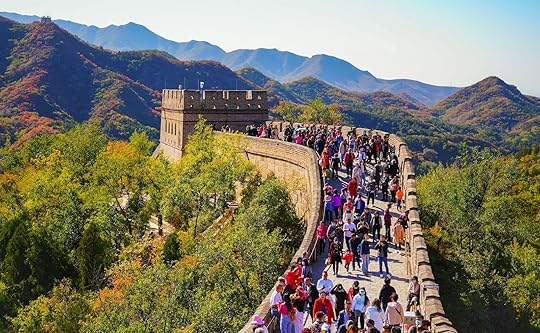
Photo: Javen/Shutterstock
From Beijing, you can access eight sections of the Great Wall. While each has its own unique appeal and is well preserved, there are three standout sections that rank highest in terms of popularity and visitor ratings: Badaling, Mutanyu, and Jinshanling.
Badaling is by far the most popular. As the closest to Beijing, it’s extremely crowded, and usually overrun by Chinese locals, given that it’s the most accessible by public transport. Though Badaling is home to a large, castle-like fortress and is one of the more easily walked sections, Badaling isn’t the best choice for first-time or foreign visitors (or any visitors). The crowds seriously detract from the experience, and the other two standout sections are much more scenic and just as well preserved, with equally accommodating facilities.

The Jinshanling section of the Great Wall of China. Photo: hecke61/Shutterstock
Some 45 miles from downtown Beijing, Mutianyu is noticeably less busy than Badaling and increasingly popular among foreigners. It’s reachable from Beijing in about 90 minutes by car or bus and two hours by public transportation, making it only 30 minutes further than Badaling. Mutianyu is easily walked, great for families with kids, and arguably the most fun section of the wall, thanks to the toboggan slide, chairlift, and cable car. It’s also greener, thanks to the surrounding vegetation.
Jinshanling is the most beautiful, secluded, and photogenic section of the wall, but it takes more than two hours by car or even longer by city bus to reach it. However, your reward for doing so is peace, quiet, and arguably the best hiking of any section of the wall. Jinshanling’s views, ornate architecture, and tranquility are all incredible and likely what travelers picture in their mind when thinking of the Great Wall of China.

Photo: Maridav/Shutterstock
You can easily visit the Great Wall of China on your own, but you’ll find lots of guided tours available, too. Guides handle all logistics, including transportation, tickets, and sometimes meals, which is especially helpful if you don’t speak Mandarin or want to avoid the hassle of navigating public transportation. Guides can also provide more in the way of historical context, stories, and cultural insights that you may miss on your own. And if you’re visiting a more “wild” section further out, like Jiankou, guides can help you avoid some of the more impassable areas.
Self-guided visits are entirely feasible and popular, especially for well-developed sections like Mutianyu and Badaling. Going without a guide gives you maximum flexibility for setting your own pace, lingering as long as you want, and deciding spur-of-the-moment how far to stroll. It’s also more affordable, as you’ll pay just entry fees and transportation, not guiding fees or tips. But you’ll need to do more planning, including figuring out your transportation in advance and buying tickets on site. And remember to download a map or route in advance, especially if you’re used to relying on Google Maps and Wi-Fi everywhere you go. 
Where to Eat, Play, and Stay During the 2026 Vancouver World Cup Matches

Vancouver, Canada, is one of only two cities in Canada of the 16 hosting the 2026 FIFA World Cup. While that could be because Canada doesn’t have as many cities with facilities capable of hosting such a big event, we like to think it’s because you won’t find a better place in Canada for hosting such a noteworthy event. (Though, in fairness, we’re also excited about Toronto’s games).
Vancouver has a rich sports legacy that’ll be the perfect stage for the 2026 FIFA World Cup, building on decades of athletic achievement and passion from the international community. It’s long been a hub for major sporting events, from the Vancouver Millionaires’ early 20th-century hockey streak to the enduring popularity of the Vancouver Whitecaps, the city’s beloved Major League Soccer team. The World Cup will be just one of many noteworthy events that have been held at the BC Place Stadium, including the 1983 Soccer Bowl and the opening and closing ceremonies of the 2010 Olympic Winter Games.
Hosting the winter Olympics was a transformative moment for sports in Vancouver. Not only did it show the city had the fanbase to host global athletic events, but also showed it had the infrastructure for visitors to come into the city en masse for events. The Vancouver World Cup matches will be some of the most exciting, partially because of the location: BC Place Stadium is in the heart of downtown Vancouver, super close to all the city’s best things to do.
Here’s what you should know before you plan your trip to the Vancouver World Cup games, along with where to stay and where to watch the action when you aren’t at the stadium.
We hope you love the spaces and stays we recommend! Just so you know, Matador may collect a small commission from the links on this page if you decide to book a stay. Listed prices are accurate as of the time of publication.
Sporty Things to Do in VancouverCheer on the Vancouver Whitecaps FC

Photo: Mark Fann/Shutterstock
Not all cities hosting World Cup matches in 2026 have their own Major League Soccer teams, but Vancouver certainly does: The Vancouver Whitecaps FC are the city’s pride and joy for soccer fans. Top Whitecaps players like Sam Adekugbe and Richie Laryea will almost certainly be playing in the World Cup, so the hometown spirit will be high. The Whitecaps also have a passionate supporters’ group: the Southsiders, who ensure every game is high energy.
The regular season usually runs from late February to mid-October, though it may be a little different in 2026, as the regular MLS season gets put on hold during the World Cup. Tickets for Vancouver World Cup games will likely be pricey, but Whitecaps tickets start under $30 Canadian, or about $23 USD.
Explore the Richmond Olympic Oval
Photo: Ronnie Chua/Shutterstock
Just a quick 25-minute ride from downtown Vancouver on the Canada Line SkyTrain is the Richmond Olympic Oval. It was built for the 2010 Winter Olympics as a speed-skating venue, but is now a modern, multi-sport facility and museum open to the public. Inside, there’s an ice skating rink (with rentals), indoor climbing, and courts for drop-in, open games like basketball, volleyball, and even badminton.
For visitors, the coolest attraction is probably the ROX, or Richmond Olympic Experience. It has interactive exhibits, displays of Olympic memorabilia, and high-tech sport simulators where you can experience slightly less accessible Olympic events, like ski jumping and bobsledding. Tickets are a reasonable $15.50 for adults.
Join a FIFA Fan Festival
Photo: Vancouver FIFA World Cup
Vancouver’s official fan festival location has already been announced: Hastings Park, east of downtown and conveniently near the bridge to North Van. According to the announcement, the festival will have live entertainment, cultural showcases, and lots of food and drink. There will also be a huge outdoor screen in the amphitheater to accommodate the thousands of people keen on watching the games from around North America.
Hastings Park is one of the largest public spaces in the greater Vancouver area, and currently hosts events like the massive PNE Fair and A-list summer concerts. Just in time for the Vancouver World Cup games will be the completion of the Freedom Mobile Arch Amphitheatre, a 10,000-person venue expected to be finished in early summer 2026.
Break a sweat on a bike tour
Photo: Airbnb
With Stanley Park and the gorgeous Seawall bike path inside the city limits, Vancouver is one of the best cities in North America for getting outdoors. One of the most fun ways to see the city while getting in a bit of fresh air is on a guided cycling tour, like this one from Airbnb Experiences. It’s a four-hour tour through lush forests and along scenic sections of the waterfront. Visitors will ride through Pacific Spirit Park’s towering trees, then pedal along the Seawall to Stanley Park with stops at the famous totem poles and Siwash Rock. It then continues to Granville Island’s public market, with time to taste samples and soak in the lively atmosphere.
Tours are hosted by a long-time local and experienced cyclist, starting at $125 Canadian (about $100 USD) per person.
Book NowGet professional-level leg muscles
Photo: Lijuan Guo/Shutterstock
The Grouse Grind is Vancouver’s most iconic and challenging hike, ascending the southern slope of Grouse Mountain in North Vancouver. It’s only about 1.5 to 1.8 miles long, but gains a punishing 2,800 feet of elevation. Starting at the base near the Grouse Mountain Gondola, you’ll climb nearly 3,000 rocky and wooded steps through a beautiful coastal forest. Fortunately, progress is marked every quarter of the way. Unfortunately, the steepest sections are in the final half. At the summit is the Grouse Mountain Chalet, at which point hikers need to take the Skyride Gondola down, as reverse hiking isn’t allowed. It’s tough, but will help you get calves like a soccer player in no time.Where to eat and drink during the Vancouver World Cup matches
View this post on InstagramA post shared by The Cambie Bar & Grill (@cambiegastown)
Doolin’s Irish Pub used to be the official pub partner of the Vancouver Southsiders (the Whitecaps’ most passionate supporter’s group) for many years. But when that pub closed, the Southsiders made a move to popular bar The Blarney Stone, Vancouver’s longest-running Irish bar. That means the bar is pretty much always packed with fans on Whitecaps match days — and, often, has a few Whitecaps players themselves when other matches are on the many TVs. The pub’s welcoming vibe, central location, and commitment to showing all Whitecaps home and away matches make it a prime spot for player sightings and fan camaraderie. The viewing parties are always a good time, complete with live commentary, contests, and food and drink specials. It gets raucous, so don’t go here looking for a laid-back spot to have a quick meal.
The Blarney Stone: 216 Carrall St, Vancouver, BC V6B 2J1
The Cambie Bar & GrillA beloved local pub near BC Place, The Cambie is a hotspot for soccer fans. It’s known for its lively atmosphere during international matches, with multiple screens, great beer selection, and classic pub fare. It’s a dive bar in the best way possible, and since it doesn’t have one nationality in particular it cheers for, you can come in regardless of whether you’re wearing green and yellow for Ghana or black and red for Japan. Expect to see fans from all over the world gathering to cheer on their teams.
The Cambie: 300 Cambie St, Vancouver, BC V6B 2N4
The Italian Cultural CentreFor authentic Italian cuisine and a passionate soccer crowd, the Italian Cultural Centre in East Vancouver is a must-visit. The Centre is a hub for Italians in Vancouver, with everything from cultural events to lectures, sporting events, and an Italian book club. But during the Vancouver World Cup games, you can bet it’ll be hosting an event (and cheering for Italy). The Centre is home to Osteria al Centro, and we’d be absolutely flabbergasted if it didn’t host huge crowds when the World Cup is underway.
The Italian Cultural Centre: 3075 Slocan St, Vancouver, BC V5M 3E4
Where to Stay for the Vancouver World Cup matchesOne of the best things about attending the Vancouver World Cup matches is that BC Place Stadium is in the middle of downtown. You won’t have long public transit rides to reach the stadium, and after games, it’s likely that enthusiastic crowds will spill out of the stadium and fill local bars and restaurants with soccer fans. So if you want to stay nearby and be able to walk to all the action, you’ll want to choose accommodations in downtown Vancouver, or somewhere near a SkyTrain station. Downtown Vancouver Airbnb next to BC Place

Photo: Airbnb
Staying downtown puts you steps away from BC Place, and this one-bedroom condo is literally the closest you can get without sleeping on the field. It’s a bit pricey, but for convenience and views, it’s absolutely unbeatable. Book NowDowntown Airbnb with ocean views
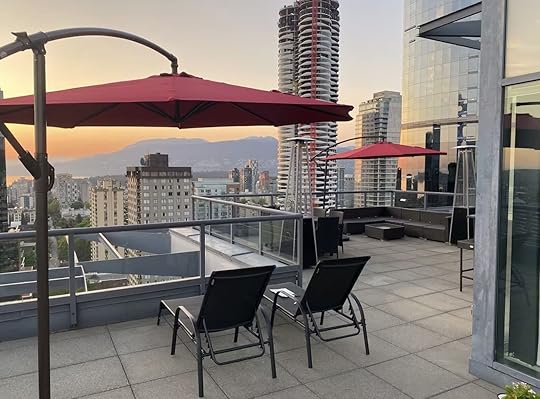
Photo: Airbnb
This chic Airbnb exemplifies Vancouver, with a location smack in the middle of downtown, but views looking out at gorgeous mountain and ocean vistas. It has two bedrooms and two baths for families or couples traveling together, plus a huge private deck with more than 1,000 square feet of outdoor living space. The Vancouver World Cup matches are happening in the middle of summer, so it’ll be ideal weather for sitting outdoors in the evenings (when you’re not out exploring the city, of course). Book NowThe Fairmont Pacific Rim

Photo: Booking.com
If you’re looking to splurge, the Fairmont Pacific Rim is arguably the nicest hotel in downtown Vancouver, with luxurious rooms that have stunning views of the harbor and mountains. It’s just a short walk from BC Place and close to a public transit line for game days, but close enough to everything else in the city (like Canada Place and Stanley Park) for when you’re not cheering on your team of choice.
 Book NowMore like thisInsider GuidesWhy Anyone Who Loves Great Food and Shopping Needs to Plan a Trip to Downtown Vancouver
Book NowMore like thisInsider GuidesWhy Anyone Who Loves Great Food and Shopping Needs to Plan a Trip to Downtown Vancouver
Happening Now: Save Up to 40% on Outdoor Gear at the 2025 REI Anniversary Sale

The 2024 REI Anniversary Sale runs from May 17 through May 27. You can save up to 30 percent on items including tents, sleeping bags, backpacks, clothing, and more. If you’re an REI Coop Member, you’ll get an even bigger discount as you’ll get one coupon for 20 percent off any item plus a second coupon for 20 percent off an REI Outlet item (they’re both tied to your account already).
These are the items we’re most excited about (or check out the full list of items on sale).
Note that REI Coop members have access to the best gear deals. Not a member? No worries, you can sign up here now and take advantage of savings right away.
We hope you love the REI Anniversary Sale! Just so you know, Matador may collect a small commission from the links on this page if you decide to make a purchase. Listed prices are accurate as of the time of publication.
30 percent off: a tent that’s already half the price of its competition
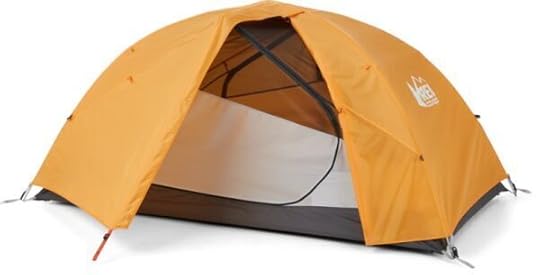
Photo: REI
REI Coop’s iconic tents are the best camping deals at this year’s REI Anniversary Sale. Also on sale are all Footprints and accessories for camping (the list is extensive). Prices range from sub-$200 to $500+ depending on size and model, and there’s never been a better time to grab a large-group tent like the Base Camp 6, which will be more than $150 off its normal $549 pricetag. this sale is to The brand’s smaller tents are compact and light enough to fit in a standard backpacking pack without adding much weight, but spacious enough for campers and gear (because no one likes to leave their pack outside in the rain). The two-person Trail Hut is durable and competent, without the flashiness or added features (read: added weight) of higher-end or sport-specific tents. It’s less than half the price of comparable tents from established outdoor brands.
Matador editor Tim Wenger is a big fan of the REI Halfdome tents — he’s owned the two- and three-person options and breaks down the details on them in a detailed review.
30 percent off: all REI Coop sleeping bags, pads, and accessories
Photo courtesy REI
The Magma 15 sleeping bag will be under $400 likely for the only time this year, so if you plan to camp in spring or fall, grab one now. Sleeping pads in various sizes and shapes are under $150, and often much cheaper depending on which one you select. You can even grab the Campwell camping pillow for just over $20.
30 percent off: REI Coop clothing and footwear — literally all of it
Photo courtesy REI
From rain jackets to hiking socks to trail pants, REI has included literally all of its clothes in this massive anniversary sale. There is, of course, the outdoorsy cliche of showing up at the trailhead looking like REI blew up all over you, but when high-quality, well-sourced clothing is so steeply discounted, you’re the one that should be laughing at those who missed out.
30 percent off: portable outdoor furniture for comfortable camping Photo: REI
Photo: REI Photo: REI
Photo: REI Photo: REI
Photo: REIWhether you’re car camping this summer or just need to spruce up your patio, REI Outward Furniture is the perfect addition, especially at 30 percent off. This is the best deal of the year on popular items like the Campwell and Wanderland Chairs and don’t miss this chance to grab the Outward Chair for 50 percent off. Toss in an efficient side table (because you don’t want to spill your drinks or food) and you effectively have an entire living room for the campsite.
25 percent off: four-season down jackets and fleece Photo: REI
Photo: REI Photo: REI
Photo: REISummer evenings can be chilly if you’re camping at high elevations (or just outdoors in a strong wind). The Cotopaxi Abrazo fleece counteracts that chill by keeping you warm and dry, and brightly stylish to boot. The Abrazo comes in half-zip or full-zip options with two pockets for your paws. It’s super versatile since you can wear it year round — just use it as an insulative layer under your thinner ski shells come winter. For under $80, that’s a heck of a deal.
Also, this is the time to grab that puffy jacket you’ve been eyeing for next winter. Cotopaxi’s robust line of Fuego down jackets are 30 percent off during the REI Anniversary Sale, as well. And the brand is known for being an industry-leader in both environmental sustainability and social justice.
25 percent off: water bottles you can drop off a cliff
Photo: REI
A water bottle that keeps your drink cold for hours, or even days, is exactly what summer calls for. All HydroFlask water bottles are 25 percent off during the REI Anniversary Sale, which can save you as much as $25. Stainless steel, eco-friendly construction and design, and leak-proof lids are just a few of the reasons why HydroFlask bottles are the go-to for Matador’s outdoor team. They’re also ridiculously durable, and HydroFlask supports Parks For All, which works to increase exposure to wildlands for marginalized groups traditionally left out of outdoor recreation.
30 percent off: tall REI branded backpacks, trekking poles, and accessories
Photo courtesy REI
All of REI’s best-selling packs are 30 percent off. This is ideal if you need a new daypack or overnighter — the brand’s packs are dependable and tough enough that they are perfect for laptop warriors and trail blazers. REI trekking poles are normally $79.95, on sale for sub-$60 during the sale. You can grab a Flash 22 pack for just over $40 or a Trail 25 pack for just over $70.
Shop REI packs and trekking poles
25 percent off: Osprey Atmos AG and Aura AG backpacks
Photo courtesy REI
Osprey’s Atmos and Aura tents are known for their AntiGravity suspension system, which eases the load on your shoulders so you can get deeper into the forest or desert. Each features Osprey’s signature lumbar support and well-ventilated back panel, helpful for summer hikes on hot days and anytime you’re trekking through the desert. The packs also feature highly adjustable torso length straps. These packs are above $300 normally, making this a great time to snag one for summer treks.
25 percent off: all Black Diamond climbing gear
Photo: Oleksii Klonkin /Shutterstock
All Black Diamond climbing gear, from ropes and harnesses to helmets and headlamps, is 25 percent off during the REI Anniversary Sale. Stock up your kit for summer climbs, and if you’re just getting into the sport, now is a great time to tick off all that new gear you need to buy.
Shop Black Diamon climbing gear
Didn’t see what you want here? Check out the full list of items on sale 
More like thisBackpackingThe Ultimate Summer Backpacking Gear Guide
The Way of Tea: How a Canadian Martial Artist Became a Tea Master in Kyoto

Born in Canada, Randy Channell Soie’s journey to Kyoto began with a fascination for Bruce Lee and a move to Hong Kong in the 1970s to study kung fu. What began as a pursuit of martial skill evolved into a lifelong search for philosophical balance. That search eventually brought him to Japan, where he immersed himself in budo (Japanese martial arts) and ultimately found his unexpected path through a neighbor who happened to be a teacher of chado, or way of tea.
“The moment I entered her tearoom, I was struck by how the movements mirrored martial arts,” he recalls on the latest episode of Matador Network’s No Fixed Address podcast. “The way you bow, walk, hold an object—there’s shared discipline and control.”
Today, Soie is an author, tea master, and professor in the way of tea in Kyoto. In this interview held in Soie’s Kyoto tearoom, he explains how a single bowl of matcha can shift your perception of time, presence, and reality itself.
Soie refers to chado as a “composite art.” Through it, one encounters architecture, ceramics, ironwork, textiles, and calligraphy. His teachings and book, The Book of Chanoyu: Tea… the Master Key to Japanese Culture, explores these intersections. “You can’t understand Japanese aesthetics without understanding tea,” he tells No Fixed Address host Michael Motamedi.
Kyoto, where Soie has lived for over 30 years, is the spiritual home of tea in Japan. The first tea plantations, brought from China in the 12th century by the monk Eisai, were established here. The city remains a center for traditional arts, and practitioners of the Urasenke (which loosely translates to tea ceremony) tradition still train new generations of followers. Soie himself teaches at Doshisha University and remotely to students worldwide.
In chado, as practiced by the Urasenke school, tea is not merely a beverage. It’s an experience built on four ideals: wa, kei, sei, and jaku (harmony, respect, purity, and tranquility). Guests are not served; they are honored. The space is not decorated; it is curated with seasonal intention. “When I serve tea,” Soie explains, “80 percent of the experience is for the guest, 20 percent for me. But in truth, it’s reciprocal.”
The ceremony centers on presence. The Japanese concept of ichigo ichie — one time, one meeting — guides every gathering. “You could repeat every movement tomorrow and it still wouldn’t be the same,” he says. “That moment only exists once.”
The deeper one listens to Soie, the more chado emerges as a metaphor for life. The process demands resilience. “Even in tea, things go wrong,” he says. “But you keep going. You don’t let it show. That’s hataraki — the ability to adapt.” The practice also instills humility. “After 30 years, I know I haven’t even scratched the surface.”
In a world consumed by digital distraction, Soie’s work is a quiet counterpoint.
“The past is the past, the future is unknown,” he says. “But this moment, right here, is real. That’s where beauty lives.” 
May 14, 2025
I Traveled Solo to New Orleans for a Date With Jazz Fest, and This Hotel Was the Perfect Base Camp

Traveling solo to a new destination can stir up a mix of emotions. But when I landed in New Orleans, I felt all the excitement with none of the accompanying hesitations. I didn’t worry about whether the restaurants’ vibes would welcome a table for one or if I’d end up lingering without making friends while going out. I was there for Jazz Fest, nothing more, nothing less. As someone who grew up in Miami and went to Ultra Music Festival every year before I learned to drive, massive musical celebrations hold a special place in my solo traveler heart.
For starters, it behooves you to attend alone, especially if you want to follow the beat of your own taste regarding the varied performances across multiple stages. Sure, there are always marquee names that draw crowds during peak hours, but for me, the real fun is bouncing from stage to stage on a whim all day, discovering new artists.
“Jazz Fest isn’t like Mardi Gras or Halloween,” a guy at the Sheraton New Orleans Hotel, where I was staying for the weekend, told me. I’d been to the French Quarter twice before for those occasions, and I assured him I wasn’t there to party but to vibe.
Typically held over two weekends on the last weekend in April and the first weekend in May, Jazz Fest (officially the New Orleans Jazz and Heritage Festival) is considered New Orleans’ biggest music festival — an impressive feat for a city that’s famous for its music scene and throws upwards of 130 festivals each year.
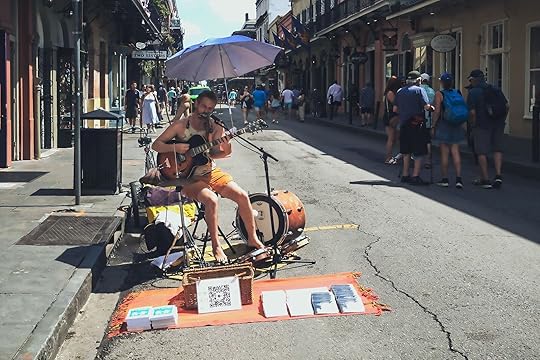
Photo: Jamie Valentino. Shot on Fujifilm X100VI Digital Camera
The Sheraton had a VIP tent at the festival, so transportation was a breeze, considering the hotel had buses transporting guests on the clock throughout the day. The night before, the club Oz on Bourbon Street kinetically summoned me to party like the nightlife version of Call of the Wild, so I arrived at my seat with shades on, already feeling like it was day two of the festival even though it had just started. But that’s part of the culture here — always erring on the side of indulgence. It didn’t help that the Sheraton is just blocks away from the coolest neighborhood in the US. It’s hard to ignore the French Quarter when you know what lies inside, beads and all.
I made a rookie mistake and showed up at Jazz Fest at 11 AM. Needless to say, there were other people there but definitely more grass than feet. Later, a more seasoned attendee told me the ideal time is around 1 to 2 PM. Unfortunately, as the crowd grew, people seemed more interested in watching than dancing. It’s not just Jazz Fest — it’s a national crisis where phones are replacing getting your groove on. Not me, though. I got to work making society a little less sedentary, even if it was just with my own two feet.
Thankfully, the crowd got more dancey as the day went on (yet another reason to go later, people are a few cocktails in by then). Being there was a reminder of how many incredibly talented indie artists there are in the world, and how important it is for them to access platforms that bring them together.

Photo: Jamie Valentino. Shot on Fujifilm X100VI Digital Camera
It also felt like an inclusive melting pot of jazz, blues, Zydeco (native to Louisiana), rock, R&B, and hip hop for the new age — Gen Z and Millennials’ take on the soulful music my parents wished I listened to when I was a kid, rather than the dubstep and house music playing at Ultra. While I’d recommend researching Jazz Fest to understand what artists are non-negotiable, make sure to give yourself time to get lost in blissful genres you weren’t even aware of.
One of my highlights was unknowingly walking into a tent playing banda and mariachi. I’d lived in Mexico City and Tulum for a few months, but the club scene was so dominated by expats that I felt like I was in any major city with better views. This was true regional Mexican music, and I looked like a fool trying to make my dancing look more like the professionals on stage (and, apparently, the audience members who were there for a reason). I loved it anyway. As a writer, being vulnerable (and oversharing about it later on) feels like my mission on Earth.
I’m embarrassed to say my favorite musical acts at Jazz Fest were predictably Kacey Musgraves and Lil Wayne, the last main stage acts on Friday and Saturday, respectively. But the producers paid them to headline because they’re timelessly great. One surprising aspect was the food, which felt like its own festival. I tried salmon on polenta, an alligator hot dog, lobster rolls, and a KitKat — all delicacies in their own right.
Another unexpected solo travel perk was discovering that the Sheraton was hosting a business convention. It facilitated meeting someone on the apps: my date was literally zero feet away. I wished I had a boss who would turn a company retreat into a one-of-a-kind memory. Then I remembered I didn’t have a boss, which was even better.
Still, the Sheraton struck me as the perfect hotel to mix work with play: all the commercial facilities and amenities you’d need, neatly contained in a convenient environment, just steps away from one of the world’s liveliest neighborhoods.
I woke up each morning to explore the French Quarter. I enjoyed window shopping through dozens of knick-knack shops, art galleries, design and furniture boutiques, and my one true love: fashion retail. One fun activity was discovering all the nooks and crannies of side streets, with entrances and alleyways leading to the town’s best-kept secrets.
Staying at the Sheraton New Orleans Hotel, anytime
Photo: Jamie Valentino. Shot on Fujifilm X100VI Digital Camera
New Orleans’ Sheraton is a perfect humble abode for the solo traveler, especially if you land a room on one of the higher floors. The building towers 46 stories over the city and the sea. As far as four-star hotels go, my stay didn’t feel as luxurious or distinctive as boutique hotels or other high-end chains, but the rooms and service left nothing to be desired. (Request the king bed because you need luscious rest after all the play.)
When I travel alone, I care less about a hotel with an Instagram-worthy aesthetic and more about practicality that truly enhances my stay. The Sheraton is free of influencer pretense. Instead, it offers a 24-hour gym that lets me complete my full workout without having to “adjust,” bountiful spots to get work done, and a location that makes it easy to jump in and out of the action depending on your mood.
Various dining options are within and next to the hotel, including an adjacent Starbucks. There’s also a rooftop pool near the gym (for a dip after some dips!). Beyond the French Quarter, you’re also in the city’s business district and just a few streets from Harrah’s Casino. That location makes for easy access to entertainment once you’re checked into the hotel, but it also makes getting there a breeze, whether you opt for public transportation or the 20-minute drive.
Oh, and at 1,110 rooms, there are plenty of other guests to mingle with — so even if you’re traveling solo as I did, you only have to be alone if you want to. 
The Best Hotels Near Atlanta’s Mercedes-Benz Stadium for Soccer Fans

Atlanta’s Mercedes-Benz Stadium is gearing up for back-to-back summers in the global soccer spotlight. First up: the 2025 FIFA Club World Cup, where teams like Chelsea, Inter Miami, and Manchester City will take the field in June and July. The stadium returns to center stage for the 2026 FIFA World Cup, hosting eight matches, including a semi-final. Whether you’re looking for a five-minute walk or a short MARTA ride, Atlanta has plenty of options when it comes to accommodations. Prices remain competitive for now, but with two major FIFA events on the calendar, demand is climbing fast. From skyline views to luxury hotels where the teams themselves might be staying, these are the best hotels near Mercedes-Benz Stadium to book before the rush.
We hope you love the hotels near Mercedes-Benz Stadium we recommend! Just so you know, Matador may collect a small commission from the links on this page if you decide to book a stay. Listed prices are accurate as of the time of publication.
The best hotels near Mercedes-Benz StadiumEmbassy Suites by Hilton Atlanta at Centennial Olympic Park
Photo: Booking
Location: 267 Marietta St NW, AtlantaHow far from the stadium: 10-minute walkPrice: From $176Embassy Suites by Hilton Atlanta at Centennial Olympic Park is just a 10-minute walk from Mercedes-Benz Stadium and is located directly across from the park that hosted the 1996 Summer Olympics. Each suite features a separate living area, microwave, mini-fridge, and wet bar — ideal for traveling with friends or simply enjoying extra space. Onsite dining includes Ruth’s Chris Steak House with views of the park, and next door, Kwan’s Deli and Korean Kitchen offers quick bites. A Starbucks in the lobby makes it easy to grab coffee before kickoff, while the rooftop pool provides a breezy retreat after the game. Guests can enjoy a complimentary breakfast with made-to-order omelets and fresh fruit, and unwind each evening with snacks and drinks at the daily reception.
BookGlenn Hotel, Autograph Collection
Photo: Booking
Location: 110 Marietta St NW, AtlantaHow far from the stadium: 10-minute walkPrice: From $159 per nightNot far from the Embassy Suites, the Glenn Hotel offers a boutique alternative housed in a 1923 limestone tower — one of Atlanta’s earliest skyscrapers. It stands out among the surrounding steel-and-glass high-rises with a historic façade, where modern touches — leather seating, bold colors, and abstract art — sit alongside original architectural details. Guest rooms feature a palette of deep green and mustard, complemented by patinated mirrors and heavy, luxurious curtains. For those with a flexible budget, the 850-square-foot penthouse suite offers a lot more space, a dining table for eight, and sweeping panoramic views of downtown. Most guests are drawn to the rooftop SkyLounge, known for its wraparound skyline vistas and cocktails like the cucumber-mint Glenntini, while Glenn’s Kitchen serves up elevated Southern classics downstairs. The central location — less than 10 minutes on foot from the stadium, the aquarium, and Centennial Olympic Park — makes the Glenn an easy pick for travelers who care as much about atmosphere as they do about being close to the action.
BookHotel Indigo Atlanta Downtown
Photo: Booking
Location: 230 Peachtree Rd NE, AtlantaHow far from the stadium: 20-minute walkPrice: From $123 per nightHotel Indigo Atlanta Downtown sits inside a revamped tower on Peachtree Street, just a 20-minute walk northeast of Mercedes-Benz Stadium and directly connected to the MARTA rail system. The building was originally designed by Atlanta architect John Portman, known for his futuristic hotel atriums and the glass elevators that became hallmarks of his signature style. One of his most recognizable features — a dramatic steel-and-glass staircase — now spirals through the lobby, a sculptural centerpiece that reflects the geometric precision of his nearby Hyatt and Westin towers. Rooms are clean-lined and quietly stylish, with high ceilings, generous windows, and headboards set against charcoal panels. The hotel connects directly to the Peachtree Center transit hub and is within a few blocks of major downtown attractions making it an easy landing spot between games. Downstairs, The Drafting Table serves excellent bourbon cocktails and a crowd-pleasing menu until 10 PM.
BookHyatt Place Atlanta Centennial Park
Photo: Booking
Location: 300 Luckie St NW, AtlantaHow far from the stadium: 20-minute walkPrice: From $150 per nightHyatt Place sits across from the Georgia Aquarium and just a short walk from Centennial Olympic Park, with Mercedes-Benz Stadium reachable in about 20 minutes on foot. The location does a lot of the heavy lifting — near enough to downtown’s biggest attractions that you can skip rideshares, but just far enough to sidestep matchday bottlenecks. Rooms deliver what you’d expect from a Hyatt at this level: clean, consistent, and equipped with mini-fridges, coffee stations, and seating areas that make the space feel more usable. There’s a modest gym and an outdoor pool, and The Placery — its in-house bar and grill — offers a short menu of crowd-pleasers. The complimentary breakfast covers all bases, from bacon and waffles to fruit and yogurt, whether you’re fueling up or just grabbing something light before kickoff.
BookHyatt Regency Atlanta
Photo: Booking
Location: 265 Peachtree Rd NE, AtlantaHow far from the stadium: 20-minute walkPrice: From $99 per nightHyatt Regency Atlanta takes things up a level from its nearby counterpart, with nearly 1,300 rooms and a rotating rooftop restaurant crowning its 22-story atrium tower. The building itself is a landmark — one of the first atrium-style hotels ever built — and remains one of the most recognizable silhouettes in downtown Atlanta. It’s connected to Peachtree Center and within easy walking distance of Mercedes-Benz Stadium, with a direct MARTA line to the airport. The hotel has a 24-hour gym, a seasonal outdoor pool, and multiple dining options, including Sway for Southern-style breakfasts and Polaris, the rooftop lounge known for its panoramic city views. Rooms come with Hyatt Grand Beds, mini-fridges, and streaming-ready TVs. Guests booking a club-level room get access to a private lounge with breakfast and all-day snacks. The property participates in the World of Hyatt program and is classified as a Category 3 hotel — meaning free nights are available from 12,000 points, making it one of the better redemption values near the stadium.
BookInterContinental Buckhead Atlanta
Photo: Booking
Location: 3315 Peachtree Rd NE, AtlantaHow far from the stadium: 15-minute drivePrice: From $295 per nightThe InterContinental Buckhead has been chosen as a potential base camp for World Cup teams, with players expected to train at nearby Kennesaw State University. It’s farther from Mercedes-Benz Stadium than most options on this list, but still well connected — about a 15-minute drive or 30 minutes via MARTA’s Red Line from Buckhead Station. With over 400 rooms and 21 suites, accommodations include marble bathrooms, deep soaking tubs, and thoughtful touches like potted plants and plush robes. There’s a full-service spa, a heated saline pool and whirlpool, and an upscale gym. Dining options include Southern Art, helmed by chef Art Smith, and the adjacent Bourbon Bar, which stocks more than 70 premium labels. Common areas like the lobby and garden terrace offer a quieter, more refined atmosphere for those looking to stay outside the downtown buzz but close enough to jump in for fixtures.
BookJW Marriott Atlanta Buckhead
Photo: Booking
Location: 3300 Lenox Rd NE, AtlantaHow far from the stadium: 15-minute drivePrice: From $268 per nightAnother strong contender for a team base camp, the JW Marriott Atlanta Buckhead is a short drive from the Atlanta United Training Center and steps from the Lenox MARTA station — meaning you can be at Mercedes-Benz Stadium in about 40 minutes by train or 15 minutes by car. The hotel connects directly to Lenox Square, putting shops, restaurants, and Buckhead’s pedestrian core right outside the door. Rooms are quiet and spacious, with thick carpeting, marble bathrooms, and blackout curtains. You can start your day in the concierge lounge with a hot breakfast and wind it down with drinks and snacks, or opt for something more substantial at The Preserve, the on-site restaurant focused on regional flavors. With an indoor pool, a 24-hour fitness center, and the possibility of World Cup players staying at the hotel, you might just find yourself sharing the elevator with a famous face or two.
BookOmni Atlanta Hotel at Centennial Park
Photo: Booking
Location: 190 Marietta St NW, AtlantaHow far from the stadium: 10-minute walkPrice: From $159 per nightOmni Atlanta Hotel at Centennial Park is one of the closest hotels to Mercedes-Benz Stadium. Set beside Centennial Olympic Park, it offers a rare chance to stay within walking distance of every game, without needing a rideshare or train. Rooms are spacious and contemporary, many offering views of the downtown skyline or the CNN Center atrium, with marble-accented bathrooms and dedicated workspaces. You can hit the 24-hour gym with Peloton bikes, then grab breakfast downstairs at New South Kitchen, where the buffet includes build-your-own shrimp and grits, and peach cobbler French toast. The lobby-level Top Draft has a patio overlooking the park and a rotating tap list ideal for pregame rounds, while Vues Lobby Bar serves cocktails with skyline views. If convenience is your top priority — or you’re planning to walk to every match — it’s hard to beat this location.
BookReverb by Hard Rock Atlanta Downtown
Photo: Booking
Location: 89 Centennial Olympic Park Dr NW, AtlantaHow far from the stadium: 10-minute walkPrice: From $149 per nightJust a short walk from Mercedes-Benz Stadium, Reverb by Hard Rock is one of the closest stays for fans looking to swap traditional Southern luxury for something more playful and high-tech. Standard rooms come with Sealy Posturepedic beds, voice-activated lighting, and Malin + Goetz bath products. For groups, the Roadie Rooms add a second bathroom, a lounge area, and a private karaoke setup. There’s a decent gym, a ground-floor café-bar that shifts from coffee in the morning to cocktails at night, and a rooftop terrace that stays open late for drinks with skyline views.
BookSignia By Hilton Atlanta Georgia World Congress Center
Photo: Booking
Location: 159 Northside Dr NW, AtlantaHow far from the stadium: Five-minute walkPrice: From $220 per nightOpened in early 2024, the Signia by Hilton Atlanta is the newest hotel on this list — located directly across the street from Mercedes-Benz Stadium and physically connected to the Georgia World Congress Center. With 42 stories and nearly 1,000 rooms, the hotel was designed to host large-scale events. Rooms are sleek and neutral-toned, featuring floor-to-ceiling windows, Nespresso machines, and wellness-focused extras like yoga mats and essential oil–infused bath products. The hotel’s dining scene is a destination in itself, from Friendship Market, a pastry bar helmed by a standout pastry team, to Capolinea, an upscale Italian restaurant serving brioche with Calabrian chile butter and tableside martinis alongside stadium views. More than 70 curated pieces of contemporary art — including sculptures, installations, and paintings — are integrated throughout the building, transforming public spaces into a self-guided gallery. 
The Best Hotels Near LA’s Rose Bowl Stadium and SoFi Stadium for Soccer Fans

Whether you’re coming to Los Angeles this summer for the 2025 Club World Cup — with teams like PSG and Atlético de Madrid playing at the Rose Bowl — or planning ahead for the 2026 FIFA World Cup, when SoFi Stadium will host the opener and several key matches, sorting your stay early is a smart move.
The two stadiums sit on opposite ends of LA, and the hotel scenes around each are totally different. Near SoFi, most of the convenient options are clustered around LAX — big-brand, practical, and transit-accessible, ranging from basic airport hotels to spots with nice perks like pools and spas. That said, I’ve also included a few higher-end picks if you’re after more than just a place to crash between fixtures. Over in Pasadena near the Rose Bowl, you’ll find a good mix of hotels with a little more character. Whether you’re coming for the first whistle of the World Cup or the global club showcase, these are the best hotels near both the Rose Bowl and SoFi Stadium for fans looking to stay close to the action.
Jump to: The best hotels near SoFi StadiumWe hope you love the hotels near SoFi Stadium we recommend! Just so you know, Matador may collect a small commission from the links on this page if you decide to book a stay. Listed prices are accurate as of the time of publication.
The best hotels near Rose Bowl StadiumCourtyard by Marriott Los Angeles Pasadena Old Town
Photo: Booking
Location: 180 N Fair Oaks Ave, PasadenaHow far from the stadium: 40-minute walk or a five-minute drivePrice: From $186 per nightIf you’re planning to catch a Club World Cup match at the Rose Bowl, the Courtyard by Marriott in Old Town Pasadena puts you within a five-minute drive of the stadium. The property underwent an almost $13 million renovation in 2024, and it shows in the modern, minimalist rooms outfitted with comfortable beds, mini-fridges, and functional workspaces, ideal if you’re squeezing in a bit of remote work. You can grab a pre-match drink or dinner downstairs at the Courtyard Kitchen & Bar, or step out into Old Town’s walkable grid, where local favorites like Mi Piace — an upscale Italian spot — and Union, known for its seasonal Californian menu, are just a short walk away. There’s also a small outdoor pool and a gym, but the biggest perk is that the Memorial Park Metro Station is only a short walk away, linking you to the rest of LA without the headache of traffic or parking.
BookHotel Dena, Pasadena Los Angeles, a Tribute Portfolio Hotel
Photo: Booking
Location: 303 Cordova St, PasadenaHow far from the stadium: 55-minute walk, eight-minute drivePrice: From $178 per nightFor fans coming to Pasadena with a creative streak, Hotel Dena delivers a matchday base that’s anything but generic. Just an eight-minute drive or a single bus transfer from the Rose Bowl, this 311-room property nods to the city’s performing arts scene at every turn — from murals by LA-based artists to a screening room behind the lobby. Rooms come stocked with Blind Barber bath products and can be outfitted with Lume Cube ring lights on request, ideal for creators filming or taking photos during their stay. There are two onsite dining venues: Lyric serves typical SoCal breakfasts, while Agents Only, a speakeasy-style lounge, hosts live sets ranging from jazz to stand-up. Between games, take a break by the heated outdoor pool or duck into Old Town, less than 10 minutes away on foot, for galleries, bars, and bookstores worth browsing.
BookPasadena Hotel & Pool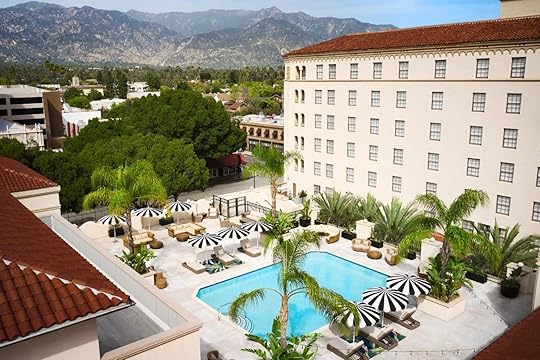
Photo: Booking
Location: 928 E Colorado Blvd, PasadenaHow far from the stadium: Seven-minute drivePrice: From $192 per nightJust east of Old Town on Colorado Boulevard — and right on the Rose Parade route — Pasadena Hotel & Pool sits seven minutes from the Rose Bowl and close to one of the most straightforward game-day transit options: a direct 30-minute bus ride from right outside the door. Originally opened in 1926, the building still wears its Jazz Age bones proudly, with a Mediterranean courtyard, Deco-style lobby, and a rooftop pool that’s become a local fixture in summer. The 161 rooms are modernized but keep a sense of quiet formality, with leather desk chairs, spa-style robes, and roomy bathrooms. South Lake Avenue, with its block of restaurants and shops, is just around the corner, and the hotel’s own lobby bar pours everything from cold brew in the morning to cocktails at night. The 24-hour gym is a plus for early risers or late arrivals, and if you’re sticking around post-match, the Huntington Library and Pasadena Playhouse are both just a short drive away.
BookThe Langham Huntington, Pasadena
Photo: Booking
Location: 1401 S Oak Knoll Ave, PasadenaHow far from the stadium: 10-minute drivePrice: From $479 per nightSet on 23 manicured acres just 10 minutes from the Rose Bowl, The Langham Huntington has been Pasadena’s answer to old-world luxury for more than a century. This five-star property sits at the base of the San Gabriel Mountains in a quiet residential pocket, where stone paths wind through Japanese gardens and palm-lined lawns. The hotel’s 379 rooms, suites, and freestanding cottages are spread across multiple buildings, with options ranging from classically styled doubles to luxury retreats with mountain views and marble bathrooms. It’s not walkable to the stadium, but the hotel offers far more than just a place to sleep — there’s an outdoor heated pool, a croquet lawn, and one of the area’s top spas. The Langham’s position also makes for easy access to nearby cultural landmarks like the Norton Simon Museum, or a post-match dinner in Old Pasadena.
BookThe Patrician Hollywood Universal
Photo: Booking
Location: Patrician Way, PasadenaHow far from the stadium: Eight-minute drivePrice: From $369 per nightFor those who’d prefer peace and quiet over a central location, The Patrician Hollywood Universal offers a high-end alternative in the hills just west of downtown Pasadena. This five-star guesthouse is less than 10 minutes by car from the Rose Bowl, but feels far removed from the city’s main grid. With just a handful of rooms and suites, a stay here is more intimate. There’s no restaurant onsite, but you’ll have access to a shared kitchen, and complimentary parking makes it easy to head out for a pre-match bite in nearby Old Town. While you’ll need a car to reach most things, what you get in return is peace, space, and standout service in a setting that feels more private villa than hotel.
BookThe Westin Pasadena
Photo: Booking
Location: 191 N Los Robles Ave, PasadenaHow far from the stadium: 50-minute walk or a six-minute drivePrice: From $218 per nightThe Westin Pasadena is just a few blocks east of Old Town and still within a short drive of the Rose Bowl. It’s the only hotel in the city with a rooftop pool, offering panoramic views of Pasadena’s City Hall dome, the San Gabriel foothills, and the low-slung grid of surrounding neighborhoods. While the tower-like exterior doesn’t give much away, the interiors blend Southwestern accents with marble floors and a lobby lounge that feels part co-working space, part library. The rooms are upscale, with warm tones, soft lighting, and Westin’s signature pillow-heavy beds, with most overlooking the mountains or the hotel’s central courtyard. On the ground floor, Ventanas Restaurant & Bar serves shareable plates and mains centered on California-grown produce, with seating available both indoors and out. Memorial Park Station is about a 10-minute walk, making it easy to hop on the Metro if you’re heading elsewhere after the match.
BookThe best hotels near SoFi StadiumHilton Los Angeles Airport
Photo: Booking
Location: 5711 W Century Blvd, Los AngelesHow far from the stadium: 10-minute drivePrice: From $162 per nightWith SoFi Stadium just a few miles from LAX, many of the most convenient hotels for matchday are airport hotels — but don’t let that put you off. These properties are some of the best-connected in the city, offering quick rides to both the stadium and the beach. Prices will rise closer to the tournament, so booking early is recommended.
The Hilton Los Angeles Airport is a solid option along Century Boulevard, just 10 minutes from SoFi Stadium and one mile from the terminals. It’s a large, practical option — especially if you’re traveling with a group or need multiple rooms — and offers all the basics for a match weekend without the higher price tag of some neighboring properties. There’s a free 24-hour airport shuttle, EV charging stations, and a spacious outdoor pool. The hotel has multiple dining options on-site, including a full-service restaurant, a 24-hour café with Starbucks coffee, and in-room dining. Rooms are straightforward but clean and comfortable, and the hotel is pet-friendly, with connecting room options and flexible layouts for families or friend groups traveling together.
BookHotel Figueroa, Unbound Collection by Hyatt
Photo: Booking
Location: 939 S Figueroa St, Los AngelesHow far from the stadium: 20-minute drivePrice: From $194 per nightIt’s not the closest hotel to SoFi, but Hotel Figueroa has one of the more compelling backstories of any place you could stay during the tournament. Opened in 1926 as a women-only hotel — founded, financed, and operated entirely by women — it was led by Maude Bouldin, a motorcycle-riding, plane-flying hotel manager who created a rare space for female travelers in an era when many hotels required male chaperones. Nearly a century later, following a thoughtful renovation, the hotel still honors that legacy with exhibitions, programs, and partnerships with women artists and organizers — including serving as a polling site during the 2024 election. Rooms are quiet and moody, with tiled bathrooms, carved wood accents, and warm Spanish Colonial detailing. On the ground floor, Café Fig does tuna tostadas and breakfast plates, while the poolside Deme serves mezze and grilled meats beneath a mural that spans the far wall. As part of Hyatt’s Unbound Collection, it’s also a smart option for those looking to redeem or earn points.
BookHotel June West LA, a Member of Design Hotels
Photo: Booking
Location: 8639 Lincoln Blvd, Los AngelesHow far from the stadium: 14-minute drivePrice: From $196 per nightIf you’re looking for something beyond the usual airport hotel circuit, Hotel June West LA is worth the extra few minutes’ drive. About 15 minutes from SoFi and positioned closer to the coast than the terminals, this 250-room property offers a more independent feel than the bigger LAX brands. Set in a mid-century building designed by LA architect Welton Becket, the hotel was reimagined during the pandemic by Proper Hospitality as a more design-conscious, lifestyle-friendly alternative — without the price tag of a Proper Hotel stay. Rooms feature white oak platform beds, noise-canceling windows, Aesop bath products, and Apple TVs, with thoughtful touches like built-in wireless chargers and desks for remote work. The main draw here, though, is the scene around the Caravan Swim Club: a Baja-inspired pool deck and terrace with fire pits, a raw bar, and an all-day menu curated by Steve Livigni, the LA hospitality veteran behind Scopa and other well-known Westside spots. For World Cup travelers who want a break from airport bustle but still need easy access to SoFi, it’s a great alternative with character and coastal access baked in.
BookLos Angeles Airport Marriott
Photo: Booking
Location: 5855 W Century Blvd, Los AngelesHow far from the stadium: 12-minute drivePrice: From $193 per nightOf the big LAX hotels along West Century Boulevard, the Los Angeles Airport Marriott stands out. The location is just as convenient (10–12 minutes to SoFi Stadium and a few blocks from the terminals) as other major brand hotels, but the experience feels a notch more refined. Rooms are well-insulated from runway noise and include plush bedding, soundproof windows, and large workstations. Downstairs, you’ll find a resort-style outdoor pool, three full-service dining options (including the steakhouse-style JW and the more casual Social Market & Eatery), plus a Starbucks. The gym is large, the lobby is busy (there’s always someone to help), and the 55,000 square feet of meeting space often fills with a mix of events and international travelers. Like its neighbors, the hotel offers a free 24-hour airport shuttle, and will likely have better transport option to SoFi come next year.
BookSheraton Gateway Los Angeles Hotel
Photo: Booking
Location: 6101 W Century Blvd, Los AngelesHow far from the stadium: 10-minute drivePrice: From $185 per nightIf you’re aiming for proximity to both SoFi Stadium and LAX, again the cluster of hotels along West Century Boulevard is hard to beat. The Sheraton Gateway isn’t my top pick among them, but if you’re sitting on Marriott Bonvoy points, it’ll do in a pinch. Just a 10-minute drive to the stadium, the hotel’s biggest strengths are location and scale: 802 rooms, a free 24-hour airport shuttle, and a full roster of amenities, including a large outdoor pool, round-the-clock gym, and multiple on-site dining options like Shula’s 347 Grill and a Brasserie buffet. Rooms come with Sheraton Sweet Sleeper beds and all the standard touches — coffee makers, minibars, and optional Club Level upgrades for extra perks. It’s a straightforward stay built for volume, with conveniences like a lobby Starbucks, 24-hour room service, and enough space to accommodate a lot of people.
BookShutters On The Beach
Photo: Booking
Location: 1 Pico Blvd, Santa Monica, CA 90405How far from the stadium: 20-minute drivePrice: From $874 per nightA luxe option near the water, Shutters on the Beach in Santa Monica is a 20-minute drive from the stadium and sits right at the edge of the sand at the end of Pico Boulevard. This long-standing hotel has built its reputation on thoughtful design, East Coast architectural touches, and service that feels personal without being showy. Rooms channel a sense of old-school coastal comfort: built-in bookshelves, soaking tubs behind shuttered windows, and balconies that open to the breeze and ocean air. Coast, the hotel’s casual restaurant, offers a daytime menu that includes cold-pressed juices, lemon ricotta pancakes, and protein-heavy dishes like steak and eggs with salsa verde, while 1 Pico specializes in local seafood — bluefin toro steak, lobster spaghetti — served under 11-foot ceilings with water views from every table. There’s no official SoFi shuttle, but the front desk will help you sort a ride, or a bike if you’re heading up the boardwalk after the match.
BookSonesta Los Angeles Airport LAX
Photo: Booking
Location: 5985 W Century Blvd, Los AngelesHow far from the stadium: 10-minute drivePrice: From $171 per nightFor something a little less corporate but still well-situated, the Sonesta Los Angeles Airport LAX offers a fresher take on the typical airport stay. Just 10 minutes from SoFi and less than a mile from the terminals, the hotel was recently renovated and now features a more modern aesthetic than some of its neighbors. Rooms are outfitted with updated finishes, and sound-blocking windows, with select options offering city views. There’s a heated outdoor pool and 24-hour fitness center, along with four on-site dining venues that range from casual café fare to more upscale options. A free 24-hour airport shuttle runs regularly, and while it’s not the flashiest option in the area, it’s clean, comfortable, and easy to navigate — exactly what you want before or after a match.
BookThe Lum Hotel Los Angeles Stadium District
Photo: Booking
Location: 3900 W Century Blvd, InglewoodHow far from the stadium: 15-minute walk or a five-minute drivePrice: From $130 per nightThe Lum Hotel in Inglewood is one of the closest hotels to SoFi Stadium — just under a mile from the entrance, or about a 15-minute walk. The location alone makes it an easy pick for matchgoers who want to avoid the transportation shuffle entirely. The 179-room hotel is part of Sonder’s portfolio, with a contemporary layout that prioritizes comfort and smart, useful details — private balconies or terraces, streaming-enabled HDTVs, and minimalist workspaces. The rooftop bar and lounge, which overlooks the stadium and Hollywood Park, is one of the area’s better post-match hangouts. There’s also a resort-style pool, a hot tub with umbrella service, and a 24-hour gym. For the price point, it’s hard to beat the convenience — especially if you’re planning to walk to the stadium and back.
BookThe Ritz-Carlton, Marina del Rey
Photo: Booking
Location: 4375 Admiralty Way, Marina Del ReyHow far from the stadium: 15-minute drivePrice: From $543 per nightSet directly on the water in Marina del Rey — closer to the docks than to the stadium — this Ritz-Carlton is one of the few World Cup options that offers a quieter, more resort-like stay without leaving Los Angeles. It’s a 15-minute drive to SoFi, and the hotel sits on one of the largest recreational marinas in the world. Rooms have private balconies that overlook either the harbor or skyline, and there’s a saltwater pool, waterfront tennis courts, and even paddleboards for rent if you’re taking a rest day between matches. Cast & Plow, the hotel’s restaurant, keeps its focus local with seasonal California menus and ingredients sourced from nearby farms and markets, and the outdoor terrace and fire pits stay busy at golden hour. At the time of writing, the hotel couldn’t confirm a dedicated shuttle to SoFi, but the concierge can arrange transport. It’s not the kind of place you’d expect to find a fan crowd, which may be exactly the point.
BookThe Westin Los Angeles Airport
Photo: Booking
Location: 5400 W Century Blvd, Los AngelesHow far from the stadium: Eight-minute drivePrice: From $196 per nightJust eight minutes from the stadium, The Westin Los Angeles Airport doesn’t feel like your average layover hotel. Renovated in 2024 as part of a $45 million overhaul, the property has 750 rooms and suites, all outfitted with Westin’s signature Heavenly Beds, upgraded workspaces, and large bathrooms stocked with spa-style amenities. The refresh extended to the lobby, the bar, and the Westin Club, where Club Level guests can grab breakfast and non-alcoholic drinks throughout the day. The Westin also puts you within easy reach of LA’s coastal stretch — beaches like Playa del Rey and El Segundo are a 15-minute shuttle ride away, and the hotel even offers a surf concierge who can guide you to the best breaks. Back on-site, there’s a large gym with Peloton bikes, a heated pool, and a restaurant that fills up with a mix of leisure travelers and locals heading out to SoFi. Complimentary airport shuttles run around the clock, and EV drivers will find more than 40 charging stations in the parking lot. 
May 13, 2025
Airbnb Reinvents Its App and Experiences – and You Could Party With Megan Thee Stallion

If Airbnb has any say in it, your next trip will be planned and booked all in one place. Today, the company that revolutionized the short-term rental industry by making it more approachable to both travelers and homeowners, announced a major revamp of its platform focused on sightseeing, tours, and other guided experiences — in an effort to bring the personal touch back to an increasingly distracted and segregated travel marketplace. Airbnb launched Services and relaunched its Experiences tool as part of a significant shift in its strategy to directly compete with established players like Viator and GetYourGuide. Moving beyond its original focus on niche, host-led activities, Airbnb will now include mainstream landmarks and attractions in 650 cities worldwide – all to tie in a closer connection between where you stay in a location and what you do there.
“Seventeen years ago, we changed the way people travel. More than two billion guests later, Airbnb is synonymous with a place to stay,” said Brian Chesky, Airbnb co-founder and CEO. “With the launch of services and experiences, we’re changing travel again. Now you can Airbnb more than an Airbnb.”
Just so you know, Matador may collect a small commission from the links on this page if you decide to make a purchase.
The Airbnb app gets a major makeover – and introduces Airbnb Services
Photo courtesy Airbnb
Airbnb launched Airbnb Experiences years ago, but Chesky is the first to say the program hasn’t, until now, lived up to its potential. The 2025 Summer Release includes a complete revamp of Airbnb Experiences. Now, when you book an Airbnb accommodation, the app will suggest nearby activities or experiences to level up your stay.
New tabs, including Explore and Trips – The Airbnb app now offers more options for browsing potential trips and adding onto current trips, including a detailed travel itinerary and corresponding ExperiencesAn updated Messaging platform that allows travelers to connect before and after travel experiences
A more interactive profile – Airbnb now allows users to customize their profile to highlight places they’ve traveled, people they’ve met, and things they’ve done
Automatically generated itineraries featuring everything booked through the app in relation to an upcoming trip, all in one place
Personalized profiles for each member that allows for social connections
The app lets you book vetted chefs, trainers, masseuses, and certified professionals in seven other service sectors right on the app. Once booked, the service comes to you, and is customizable — for example, chef menus can be modified based on dietary preferences. Via the Services tab on the app, users can browse available service providers and learn more about them.
When selected, an Experience profile will display available booking times during your stay (if you have one booked in the same city) and ask if you’d like the experience to take place in your Airbnb or somewhere else. Booking is instant.
Importantly, it’s not required that you stay in an Airbnb to book these services — the company aims to offer the service to locals too, with the same perk of the provider coming to the booker. Need a photographer for an event or family gathering? This is bookable in the app, as long as you’re in one of the 260 cities in which Airbnb Services are offered.
Airbnb completely revamped Airbnb Experiences to compete with top tour listing platforms
Photo: Jackie Beale
You may notice some sleek new features the next time you open your Airbnb app. The most pertinent for travelers is the ability to create lists around a location, including places to see and things they hope to do there and info on tour operators that can make those wishes a reality. The Experiences section received a complete makeover, following the company’s pause of new Experiences listings in 2023. Now, where travelers may have looked to sites they viewed as hosting more reputable or professional tours, they can instead find these same experiences on Airbnb and book them alongside their accommodations. Itineraries can be developed through the app exclusively instead of booking a home here, a tour on another site, and a private dinner on a third.
“One of the things I’m most exicted about is having the Experiences and Services in the same place,” Tara Bunch, Airbnb’s Global Head of Operations, told Matador. “Before it was kind of hard to find these things. It was hard to search Experiences. So having this all in one place, it’s easier to search, and I love the itineraries that adapt to local time zone. It makes the whole thing more manageable.”
Notably, Experiences listings are now tailored towards locals and travelers alike. Locals may use the platform to book a hot event ticket or access to an experience that is geared to them, rather than to someone who has not been to the location before.
“Hosts get to create a geo-fence of where they’re willing to, and therefore you won’t see an Experience that isn’t in that area,” Bunch says.
Experiences available for booking include:
Chef-prepared meals and experiences, catering, and/or prepared meals for on-the-go
Photography sessions
Massage services and spa treatments
Personal training – Yoga, strength training, HIIT, and other training services
Hair, makeup, and nails
Later in 2025, guests will be able to see who else is going and where they’re from. The app will allow guests to conenct with each other beforehand, if they choose, and stay connected once the event is over. An integrated messaging platform allows guests to chat and share photos. More different types of Experiences and Originals are in the works, with plans to expand what’s available on the app in the near future.
“Youi can absolutely expect to see many more categories,” Bunch says. “Just about anything you can imagine is probably on our radar.”
The update includes the launch of ‘Airbnb Originals’
Photo: Adrienne Raquel
In the past, Airbnb Experiences consisted of booking a guided activity, typically led by a local host. The new Airbnb Originals concept, launched today, amplifies that by upping the ante on the host — often to a renowned personality in the activity. Guests can transform into an alter-ego with Megan Thee Stallion. Professional artist Shantell Martin leads a drawing experience in New York and Los Angeles, for example, where she guides groups through the loss of self-consciousness surrounding their artistic skills and helps them find their inner drawer. Airbnb Originals are meant to reflect the culture of the location and the host, and in some cases are a traveler’s best means of meeting a local celebrity.
It’s about connecting the world’s most interesting people with those who find them intersesting, Chesky says. Examples include getting in the ring with a Luchador in Mexico City, or spend a Sunday learning to throw a perfect spiral and eating barbecue with Patrick Mahomes in Kansas City. Again, behind a tourist isn’t required, nor is actually staing in an Airbnb — anyone with the Airbnb app can book these, while traveling or in their own city. Of course, these celebrities aren’t always available — so the app offers a countdown that let’s interested parties know when they become available to book.
“Today’s travel activities offer no real connection to the city you’re visiting,” said Chesky. “The most authentic way to explore a city is with the locals who know it best. With Airbnb Experiences, don’t just see a place—experience it.”
Want to host? Sign up now through the new Airbnb app
Photo courtesy Airbnb
For tour operators, getting started on the platform is designed to be as straightforward as possible. Airbnb takes 15 to 20 percent, depending on the type of activity you. host, and the rest goes to you. The new app features enhanced tools for team management and API connectivity. Marketing efforts will leverage short-form video content to engage users (which you can create), particularly targeting Gen Z travelers, and will promote experiences at various stages of the booking process to enhance discoverability.
The company is encouraging submissions from licensed tour operators and attractions, signaling a more professionalized and scalable approach to its offerings. These can include guided tours, food and drink experiences, outdoor excursions and more – effectively, if it’s available as a listing on sites like Viator and GetYourGuide, it can now be listed on Airbnb.
“Whatever you claim, we try to validate that that’s true,” Bunch says. “We want you to have at least two years of experience. We’re going to look at degrees, and if you don’t have degrees, we’ll look at your track record. Most people who sign up to host Experiences, they have a history that we can look at and verify that what you say is true.”
To lure hosts, Airbnb now offers team management and communication through its platform, including the ability to add co-hosts to a tour or listing. An array of tech tools help operators streamline their service to make it easier for potential customers to know what they’re booking, how much it will cost, where they need to arrive, and other details that, prior to this update, would have required significant back-and-forth between the host and guest. Most communication is now automated, and creating listings is more streamlined and simpler.
“If you are an expert in your city, and you have something to share, we’d love to have you apply,” Chesky said at the release event. 
Inside the New United Airlines Class With Private Suites, Caviar, and 4K Screens

United Airlines is doubling down on its premium international strategy with the launch of a next-generation cabin experience debuting on the airline’s upcoming Boeing 787-9 deliveries. At the center of the upgrade is a new, ultra-luxury business class offering called Polaris Studio.
With 25 percent more personal space than today’s Polaris business class and enhanced privacy features including full sliding doors, Polaris Studio is tailored for price-is-no-object travelers on long-haul routes. Notably, each suite includes a companion ottoman with a seatbelt — meaning passengers can host a guest during flight, which is a rare feature even among top-tier international competitors.
Polaris Studio passengers will have access to 27-inch 4K OLED screens, Bluetooth pairing, wireless charging, and a suite of high-end amenities such as Perricone MD skincare, exclusive pajamas and slippers, and a caviar service paired with Laurent-Perrier Cuvée Rosé.
Improvements don’t stop at the front of the plane. Standard Polaris seats are also getting privacy doors and 19-inch 4K OLED displays, while Premium Plus and Economy will see revamped dining and entertainment upgrades. Economy passengers will enjoy the largest seatback screens of any airline—13-inch 4K OLED displays—as well as upgraded meal offerings, though details on the new tapas-inspired service remain limited.
These enhancements are supported by broader technology investments, including multiple power outlets at each seat and Starlink internet across widebody aircraft, with free access for MileagePlus members.
The first Elevated interior-equipped 787-9 is expected to be delivered by late 2025, with inaugural flights slated for 2026 between San Francisco and key global hubs like London and Singapore. United anticipates about 30 aircraft will feature the new interiors by 2027, aligning with its push to dominate high-revenue international routes.
Each reconfigured aircraft will offer 99 premium seats (8 Polaris Studio suites, 56 standard Polaris seats, and 35 Premium Plus seats) marking a significant shift toward higher-margin cabin configurations. 
Matador Network's Blog
- Matador Network's profile
- 6 followers



